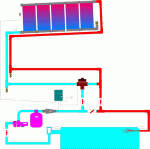I'm looking at adding a solar heating system to our pool which is currently undergoing renovation by me. It will be fully drained shortly and it occurred to me that while I am drilling holes in the walls for a second suction point and light, I may as well add another 2 and make the solar heating separate from the rest of the circulation system. Does this sound sensible? I can simply core two more holes, plumb to a separate pump attached to the solar controller and it can do its thing completely free of the rest of the system.
I've looked at how I would valve an integrated system and it was getting more and more complicated and expensive, then thought of this.
Any advice? Which way would you go?
I've looked at how I would valve an integrated system and it was getting more and more complicated and expensive, then thought of this.
Any advice? Which way would you go?



